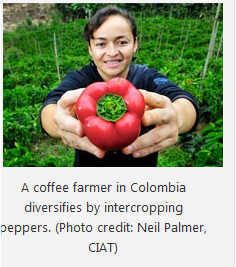 “Today’s sky-rocketing food prices are pushing more people into poverty, threatening the livelihoods of small-scale farmers, and raising concerns about global food security. At first glance, the problem seems to be one of quantity; high prices at the grocery store and local market appear to provide justification for large-scale, industrial food production. But, food security (the resilience of our food supply) is as much about the quality and diversity of our food sources as it is about how much food we produce.
“Today’s sky-rocketing food prices are pushing more people into poverty, threatening the livelihoods of small-scale farmers, and raising concerns about global food security. At first glance, the problem seems to be one of quantity; high prices at the grocery store and local market appear to provide justification for large-scale, industrial food production. But, food security (the resilience of our food supply) is as much about the quality and diversity of our food sources as it is about how much food we produce.
A recent report finds that the solutions to the price crisis won’t necessarily come from producing more food. Rather, encouraging agricultural diversity and local food production—particularly of vegetables—can help communities boost their self-sufficiency and protect vulnerable populations from price shocks.”
“Mainstream agricultural approaches typically focus on a handful of staple crops. Just three grains—maize, wheat, and rice—make up nearly 70 percent of the world’s food supply. When food producers rely on so few crops for their incomes, they are vulnerable to price volatility on the global market. In Guinea, for example, cashews dominate the agricultural sector. Farmers abandon their vegetable gardens, focusing on cashew harvests destined for export. If cashew prices fall, so do the incomes of farmers—leaving them without other food sources on which to fall back.
By selling locally and growing an array of crops, farmers are less vulnerable to market fluctuations and can sell food throughout the year. Diversification “helps protect against the risks of climate change, predators, and epidemics of diseases that attack crops,” says Serena Milano, general secretary of Slow Food International’s Foundation for Biodiversity”
“’We live in a world in which we produce more food than ever before and in which the hungry have never been so many,’ writes Olivier De Shutter, U.N. Special Reporter on the Right to Food, in the foreword to State of the World 2011. Plenty of initiatives on the ground take this simple message to heart, seeking not just to produce more food but to produce it in a way that nourishes both people and the planet. It’s time we give these initiatives the attention and funding they deserve.”

Danielle Nierenberg, an expert on livestock and sustainability, currently serves as Project Director of State of World 2011 for the Worldwatch Institute, a Washington, DC-based environmental think tank. Her knowledge of factory farming and its global spread and sustainable agriculture has been cited widely in the New York Times Magazine, the International Herald Tribune, the Washington Post, and
other publications.
Danielle worked for two years as a Peace Corps volunteer in the Dominican Republic. She is currently traveling across Africa looking at innovations that are working to alleviate hunger and poverty and blogging everyday at Worldwatch Institute’s Nourishing the Planet. She has a regular column with the Mail & Guardian, the Kansas City Star, and the Huffington Post and her writing was been featured in newspapers across Africa including the Cape Town Argus, the Zambia Daily Mail, Coast Week (Kenya), and other African publications. She holds an M.S. in agriculture, food, and environment from Tufts University and a B.A. in environmental policy from Monmouth College.








